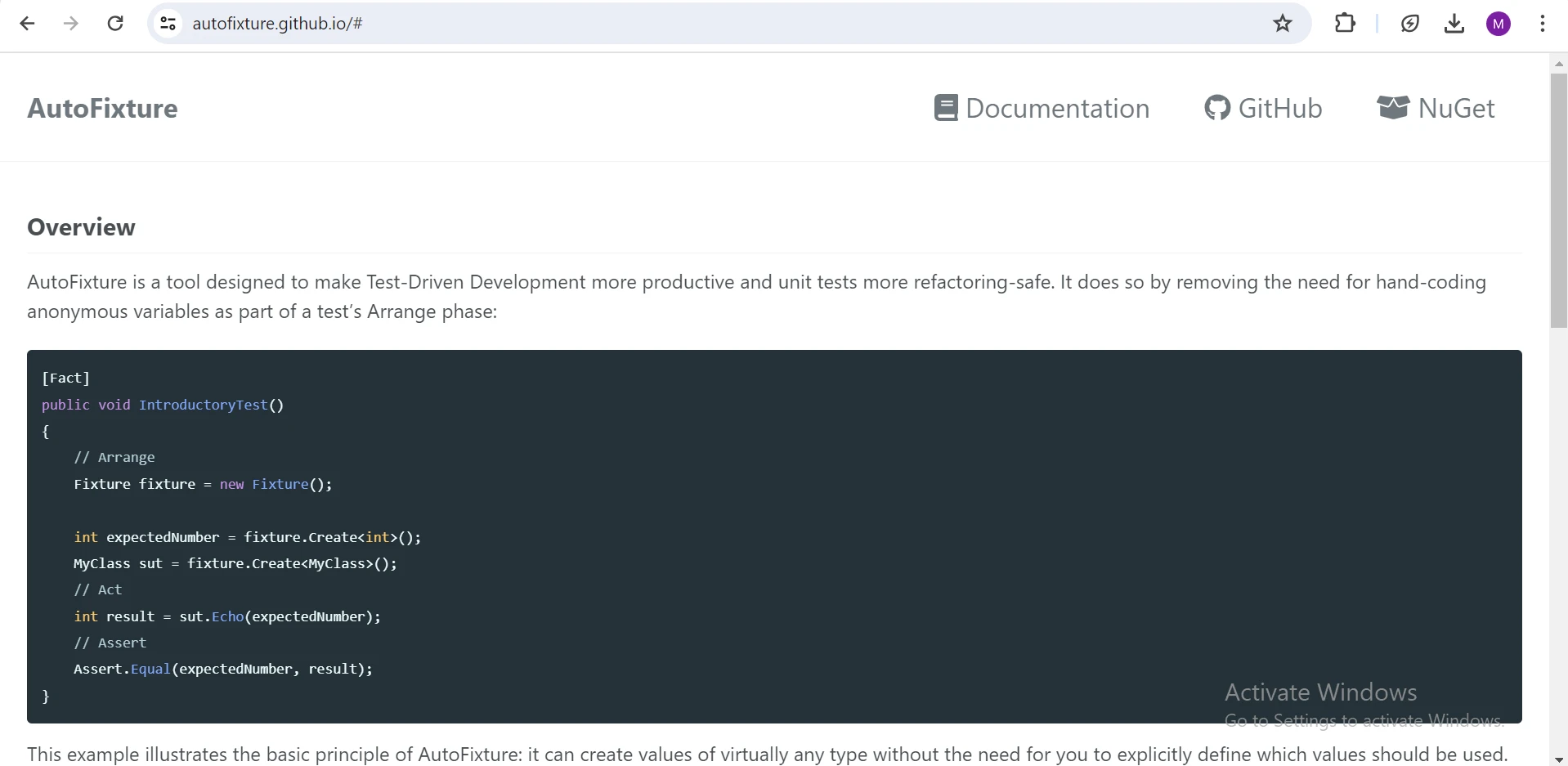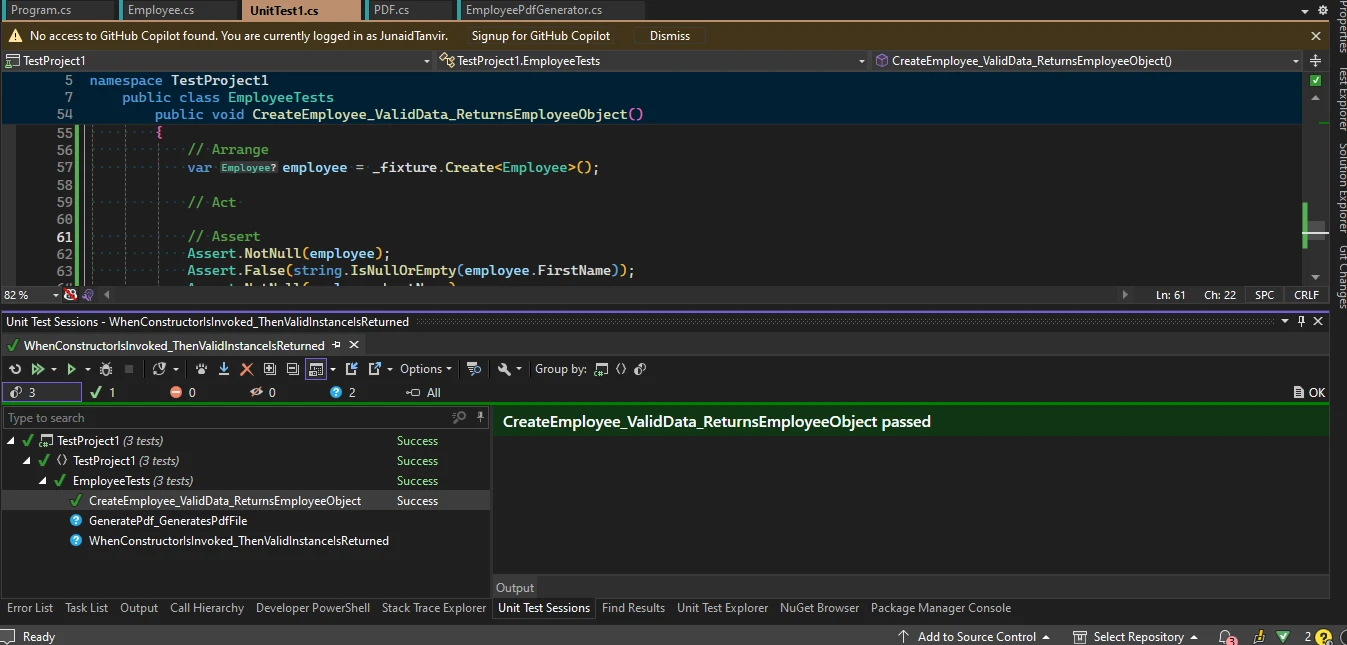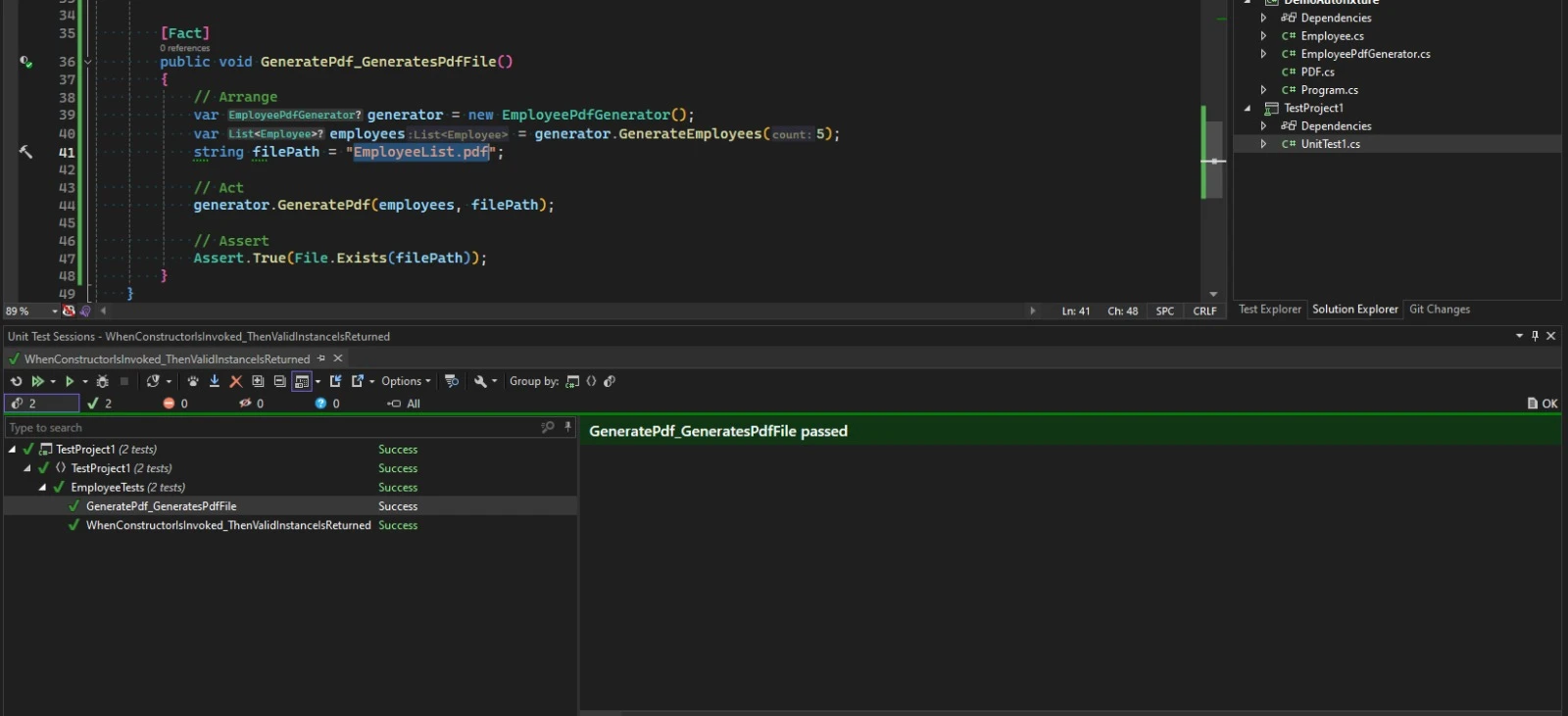Test in production without watermarks.
Works wherever you need it to.
Get 30 days of fully functional product.
Have it up and running in minutes.
Full access to our support engineering team during your product trial
AutoFixture is an open-source library for .NET aimed at minimizing the ‘Arrange’ phase of unit test writing, thereby improving test management. Its main objective is to enable developers to concentrate on what they are testing, rather than the setup process, by letting you create object graphs with test data. This article explores how AutoFixture can be used to facilitate test-driven development through efficient test data generation.
AutoFixture is a powerful library in C# designed to streamline the process of creating test data for unit tests. It helps developers avoid writing repetitive setup code by automatically generating data for test cases. In unit testing, AutoFixture provides a streamlined approach to generating test data, ensuring that each unit test is executed with varied and realistic inputs. AutoFixture makes testing in C# more efficient by automatically generating test data, reducing the need for manual setup.

AutoFixture is available as a NuGet package and can be installed. This can be done using the NuGet Package Manager Console or the .NET add package Visual Studio's NuGet Package Manager UI.
Install-Package AutoFixtureInstall-Package AutoFixtureIRON VB CONVERTER ERROR developers@ironsoftware.comNuGet will download and install the latest version of AutoFixture and its dependencies into your project.
Suppose we have a simple employee fixture instance class with properties like FirstName, LastName, and Age. Instead of manually creating instances of this new fixture class in our unit tests, we can leverage AutoFixture to generate random data for us.
public class Employee
{
public string FirstName { get; set; }
public string LastName { get; set; }
public int Age { get; set; }
public Employee(string firstName, string lastName, int age)
{
FirstName = firstName;
LastName = lastName;
Age = age;
}
public string GetFullName() => $"{FirstName} {LastName}";
}public class Employee
{
public string FirstName { get; set; }
public string LastName { get; set; }
public int Age { get; set; }
public Employee(string firstName, string lastName, int age)
{
FirstName = firstName;
LastName = lastName;
Age = age;
}
public string GetFullName() => $"{FirstName} {LastName}";
}IRON VB CONVERTER ERROR developers@ironsoftware.comNow, the Employee class encapsulates essential details of an employee, including their first name, last name, and age, represented by properties FirstName, LastName, and Age respectively. Its constructor facilitates the instantiation of an employee object by accepting these details as parameters and assigning them to the corresponding properties. Additionally, the GetFullName method concatenates the first name and last name of the employee, returning the full name as a string.
Next, we will create the code to test out:
using AutoFixture;
public class EmployeeTests
{
private readonly IFixture _fixture;
public EmployeeTests()
{
_fixture = new Fixture(); // var fixture
}
}using AutoFixture;
public class EmployeeTests
{
private readonly IFixture _fixture;
public EmployeeTests()
{
_fixture = new Fixture(); // var fixture
}
}IRON VB CONVERTER ERROR developers@ironsoftware.comThis code snippet incorporates AutoFixture into unit testing for the Employee class. By importing the AutoFixture namespace, developers access data generation functionality. The _fixture field initialized with a Fixture new instance in the constructor, streamlines test data creation. This setup enhances test efficiency and reliability for comprehensive Employee class coverage.
[Fact]
public void Employee_ShouldHaveValidValues()
{
// Arrange
var firstName = _fixture.Create<string>();
var lastName = _fixture.Create<string>();
var age = _fixture.Create<int>();
// Act
var employee = new Employee(firstName, lastName, age);
// Assert
Assert.Equal(firstName, employee.FirstName);
Assert.Equal(lastName, employee.LastName);
Assert.Equal(age, employee.Age);
}[Fact]
public void Employee_ShouldHaveValidValues()
{
// Arrange
var firstName = _fixture.Create<string>();
var lastName = _fixture.Create<string>();
var age = _fixture.Create<int>();
// Act
var employee = new Employee(firstName, lastName, age);
// Assert
Assert.Equal(firstName, employee.FirstName);
Assert.Equal(lastName, employee.LastName);
Assert.Equal(age, employee.Age);
}IRON VB CONVERTER ERROR developers@ironsoftware.comThe test method Employee_ShouldHaveValidValues validates that the Employee class correctly initializes its properties with provided values. Using a test fixture to generate random data for the firstname, lastname, and age, the test creates an Employee instance. It then asserts that the FirstName, LastName, and Age properties of the Employee object match the generated values, ensuring that the constructor sets these properties accurately.
[Fact]
public void CreateEmployee_ValidData_ReturnsEmployeeObject()
{
// Arrange
var employee = _fixture.Create<Employee>();
// Act
// Assert
Assert.NotNull(employee);
Assert.False(string.IsNullOrEmpty(employee.FirstName));
Assert.NotNull(employee.LastName);
Assert.True(employee.Age > 0);
}[Fact]
public void CreateEmployee_ValidData_ReturnsEmployeeObject()
{
// Arrange
var employee = _fixture.Create<Employee>();
// Act
// Assert
Assert.NotNull(employee);
Assert.False(string.IsNullOrEmpty(employee.FirstName));
Assert.NotNull(employee.LastName);
Assert.True(employee.Age > 0);
}IRON VB CONVERTER ERROR developers@ironsoftware.comThis test code snippet includes test assertions that validate whether the properties of an Employee object match randomly generated values. It verifies if the string type properties of string FirstName, string LastName, and int Age properties align with randomly generated values assigned to the firstName, lastName, and age variables. Any failed assertions signal a mismatch between the expected and random values generated by employee details.

IronPDF C# PDF Library is a robust C# PDF library developed by Iron Software that facilitates the reading of PDF text and the creation of PDF documents using HTML. This versatile tool enables the conversion of easy-to-format documents, complete with style information, into high-quality PDFs. With IronPDF, generating PDFs from HTML text is a seamless process, allowing users to pull HTML content from URLs and transform it into well-structured PDF files. This capability makes IronPDF an essential tool for developers looking to automate and streamline the creation of professional PDF documents directly from web content.

Open the NuGet Package Manager console, and run the following command:
Install-Package IronPdfInstall-Package IronPdf'INSTANT VB TODO TASK: The following line uses invalid syntax:
'Install-Package IronPdfWe will first create an EmployeePdfGenerator Class that contains the method to generate Employees.
using DemoAutofixture;
List<Employee> employees = new List<Employee>()
{
new Employee("John","Smith",32){ },
new Employee("Emily","Davis",18){ },
new Employee("David","Brown",24){ },
new Employee("Jane","Doe",16){ },
new Employee("Michael","Johnson",49){ },
};
EmployeePdfGenerator pdfGenerator = new();
pdfGenerator.GeneratePdf(employees, "EmployeeList.pdf");
Console.WriteLine("PDF Created Successfully!");
public class EmployeePdfGenerator
{
private readonly Fixture _fixture;
public EmployeePdfGenerator()
{
_fixture = new Fixture();
}
public List<Employee> GenerateEmployees(int count)
{
return _fixture.CreateMany<Employee>(count).ToList();
}
public void GeneratePdf(List<Employee> employees, string filePath)
{
IronPdf.License.LicenseKey = "Your-License-Key-Here";
var renderer = new ChromePdfRenderer();
string htmlContent = GenerateHtml(employees);
try
{
renderer.RenderHtmlAsPdf(htmlContent).SaveAs(filePath);
}
catch (Exception ex)
{
Console.WriteLine($"Error generating PDF: {ex.Message}");
}
}
private string GenerateHtml(List<Employee> employees)
{
StringBuilder htmlBuilder = new StringBuilder();
htmlBuilder.Append("<!DOCTYPE html><html><head><title>Employee List</title></head><body><h1>Employee List</h1><ul>");
foreach (var employee in employees)
{
htmlBuilder.Append($"<li>{employee.GetFullName()} - Age: {employee.Age}</li>");
}
htmlBuilder.Append("</ul></body></html>");
return htmlBuilder.ToString();
}
}using DemoAutofixture;
List<Employee> employees = new List<Employee>()
{
new Employee("John","Smith",32){ },
new Employee("Emily","Davis",18){ },
new Employee("David","Brown",24){ },
new Employee("Jane","Doe",16){ },
new Employee("Michael","Johnson",49){ },
};
EmployeePdfGenerator pdfGenerator = new();
pdfGenerator.GeneratePdf(employees, "EmployeeList.pdf");
Console.WriteLine("PDF Created Successfully!");
public class EmployeePdfGenerator
{
private readonly Fixture _fixture;
public EmployeePdfGenerator()
{
_fixture = new Fixture();
}
public List<Employee> GenerateEmployees(int count)
{
return _fixture.CreateMany<Employee>(count).ToList();
}
public void GeneratePdf(List<Employee> employees, string filePath)
{
IronPdf.License.LicenseKey = "Your-License-Key-Here";
var renderer = new ChromePdfRenderer();
string htmlContent = GenerateHtml(employees);
try
{
renderer.RenderHtmlAsPdf(htmlContent).SaveAs(filePath);
}
catch (Exception ex)
{
Console.WriteLine($"Error generating PDF: {ex.Message}");
}
}
private string GenerateHtml(List<Employee> employees)
{
StringBuilder htmlBuilder = new StringBuilder();
htmlBuilder.Append("<!DOCTYPE html><html><head><title>Employee List</title></head><body><h1>Employee List</h1><ul>");
foreach (var employee in employees)
{
htmlBuilder.Append($"<li>{employee.GetFullName()} - Age: {employee.Age}</li>");
}
htmlBuilder.Append("</ul></body></html>");
return htmlBuilder.ToString();
}
}IRON VB CONVERTER ERROR developers@ironsoftware.com
The provided C# code utilizes the IronPDF library to generate a PDF document listing employees and their ages. It defines an EmployeePdfGenerator class and contains method GeneratePdf, which takes a list of Employee objects and a file path. Internally, it constructs HTML content through the GenerateHtml method, then uses IronPDF's HtmlToPdf class to render this HTML as a PDF, saved at the specified file path. Enhancements include using StringBuilder for HTML generation and adding basic error handling for PDF generation and file saving.
In the below setup, AutoFixture is utilized for creating instances of the Employee class, enabling the generation of randomized data for testing. IronPDF is employed to seamlessly convert HTML content, including employee information, into PDF format. The EmployeePdfGenerator class orchestrates these processes, managing both data generation and PDF conversion efficiently. Meanwhile, the EmployeePdfGeneratorTests XUnit test class ensures the proper functionality of PDF generation through rigorous testing. This integrated approach simplifies the generation and documentation of employee data, ensuring robustness and reliability in the PDF generation process.
using System;
using System.IO;
using Xunit;
public class EmployeePdfGeneratorTests
{
[Fact]
public void GeneratePdf_GeneratesPdfFile()
{
// Arrange
var generator = new EmployeePdfGenerator();
var employees = generator.GenerateEmployees(5);
string filePath = "EmployeeList.pdf";
// Act
generator.GeneratePdf(employees, filePath);
// Assert
Assert.True(File.Exists(filePath));
}
}using System;
using System.IO;
using Xunit;
public class EmployeePdfGeneratorTests
{
[Fact]
public void GeneratePdf_GeneratesPdfFile()
{
// Arrange
var generator = new EmployeePdfGenerator();
var employees = generator.GenerateEmployees(5);
string filePath = "EmployeeList.pdf";
// Act
generator.GeneratePdf(employees, filePath);
// Assert
Assert.True(File.Exists(filePath));
}
}Imports System
Imports System.IO
Imports Xunit
Public Class EmployeePdfGeneratorTests
<Fact>
Public Sub GeneratePdf_GeneratesPdfFile()
' Arrange
Dim generator = New EmployeePdfGenerator()
Dim employees = generator.GenerateEmployees(5)
Dim filePath As String = "EmployeeList.pdf"
' Act
generator.GeneratePdf(employees, filePath)
' Assert
Assert.True(File.Exists(filePath))
End Sub
End ClassHere the EmployeePdfGeneratorTests class contains test cases for the Employee class that validated PDF on the file path.

AutoFixture simplifies the ‘Arrange’ phase of writing unit tests in .NET, offering developers a means to focus on test cases rather than setup intricacies. It streamlines the unit testing process, ensuring varied and realistic inputs by automatically generating test data. In conjunction with IronPDF Licensing Information for continued use and support.